IJCRR - 2nd Wave of COVID-19: Role of Social Awareness, Health and Technology Sector, June, 2021
Pages: 17-22
Date of Publication: 11-Jun-2021
Print Article
Download XML Download PDF
Knowledge and Attitude of First Aid Skills Among Medical, Dental and Nursing Students in the Time of COVID-19 Pandemic
Author: Gunjan Kumar, Suranjana Jonak Hazarika, Avinash Jnaneswar, Diplina Barman, Priyanka Brahma, Rameswari Acharya
Category: Healthcare
Abstract:Background: The golden hour that refers to the first hour after trauma determines the fate of the RTA victims to a large extent. When a patient does not receive first aid immediately, it affects their condition to a large extent, mostly their quality of life that eventually results in death. As future healthcare professionals, the ability to render first aid services is the need of the hour. With the increasing mortality of accidents and trauma, proper provision of first aid as the first line of treatment can help save lives. Objective: To assess the knowledge and attitude of first aid skills among medical, dental and nursing students in the time of the COVID-19 pandemic. Methods: This was a cross-sectional questionnaire-based study conducted for three months that included 300 undergraduate medical, dental and nursing students in Bhubaneswar city, Odisha. A self-structured 21 item questionnaire regarding first aid skills was used to assess the knowledge and attitude of the students. Data were entered in a Microsoft excel sheet and analysis was done using SPSS version 25. Results: It was found that 65.1% of the medical students were aware regarding first aid skills. Statistically significant differences were observed among the groups (Dental, Medical and Nursing) for the responses of the questionnaire. A moderate correlation was seen between the knowledge of first aid and individual knowledge levels. Conclusion: This study identified the need for introducing formal first aid training classes for medical, dental and nursing stu�dents and brought out the key areas in which first aid knowledge was lacking.
Keywords: First aid skills, Dental, Medical, Nursing, Trauma
Full Text:
INTRODUCTION
Approximately 1.35 million people succumb to road traffic accidents every year.1The2030 Agenda for Sustainable Development has set a target of reducing the number of deaths and injuries globally by 2020.1 In most countries, road traffic accidents incur a loss of 3% of the gross domestic product.2 In 2016, 4.94 lakh injures and 1.50 lakh deaths were recorded in India as a result of RTAs.3 The golden hour that refers to the first hour after trauma determines the fate of the RTA victims to a large extent.4 When a patient does not receive first aid immediately, it affects their condition to a large extent, mostly their quality of life that eventually results in death.3
According to the Red cross society, first aid is the first assistance or treatment given to a casualty or a sick person for any injury or sudden illness before the arrival of an ambulance, the arrival of a qualified paramedical or medical person or before arriving at a facility that can provide professional medical care.5 As a consequence of disasters, accidents or injuries the casualty requires urgent care and transportation to the nearest healthcare facility.5 Although medical students are taught how to handle emergencies in hospital settings, the knowledge required for handling a case is not adequate.6Studies have found that the knowledge of first aid among medical students has always been neglected as a topic of discussion. Hence, time and again it has come into notice that even resident doctors at certain healthcare setups cannot perform the first aid skills satisfactorily.7
Dental professionals also play an equally important role in providing first aid in their practice to a patient, relative or staff member.8 S Mathew et al. conducted a study to assess the awareness of first aid amongst undergraduate students in UAE where it was found that students belonging to the dental schools had the highest mean score as compared to other branches(8.3±2.4).9 Pei et al.carried out a study to evaluate nursing students knowledge and attitude of first aid behaviour as bystanders in a case of RTA.10 At the end of the study it was inferred that their knowledge was not satisfactory and hence it stressed conducting continuing education programmes to increase the efficiency in providing first aid skills.
The emergence of COVID-19 has raised questions among those who may need or choose to give care in an emergency. As the spread of the virus is very rapid with over more than 14 million cases in our country, the impact of first aid skills like providing other emergency casualty care is of utmost importance. While there is currently no specific data on COVID-19 transmission while performing CPR but it may be concluded that such first aid skills have the potential to generate respiratory droplets or aerosols and there may be a risk of transmission of the infection.
As future healthcare professionals, the ability to render first aid services is the need of the hour. With the increasing mortality of accidents and trauma, proper provision of first aid as the first line of treatment can help save lives. However, there is a dearth of literature related to a comparative assessment of first aid skills in students of the three specialities. Hence, this present study was taken up to assess the knowledge and attitude of first aid skills among medical, dental and nursing students.
MATERIALS AND METHODS
This was a cross-sectional questionnaire-based study conducted for a duration of three months i.e from July 2020 to September 2020. The study participants included 300 undergraduate medical, dental and nursing students in Bhubaneswar city, Odisha. Ethical approval was obtained from the Institutional Ethics Committee. Informed consent was taken from the students before the study.
A self-structured 21 item questionnaire regarding first aid skills was used to assess the knowledge and attitude of the students. For every correct answer for the knowledge questions, participants were given a score of 1 and for incorrect answers a score of 0. Questions assessing attitude were marked on a 5 point Likert scale. The validity of the questionnaire was checked by a panel of five subject experts and modifications were made accordingly before the start of the study.
The questionnaire was distributed among the study participants by the investigator and it was collected back on the same day. Training and calibration of the investigator were done in the Department of Public Health Dentistry, Kalinga Institute of Dental Sciences under the supervision of the guide. Data were entered in a Microsoft excel sheet and analysis was done using SPSS version 25. Inferential statistics were performed using Chi-square test. Categorical variables were described using frequency and percentages. Intergroup comparisons of various domain scores were done using Mann Whitney U test. The level of statistical significance was set at 0.05.
RESULTS
The Demographic characteristics such as the mean age group, the gender distribution, the year-wise distribution of the participants of various groups have been mentioned. The mean age of the participants has been mentioned in Table 1. The distribution of the gender in the groups has been graphically represented in Figure 1. The female population was higher. Figure 2 represents the year-wise distribution of the participants. It was seen that most of the participants from the dental and medical stream belonged to the third year and final year while the majority of the nursing participants belonged to the second year.
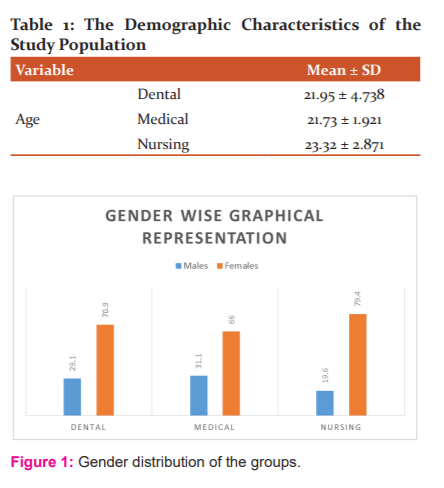
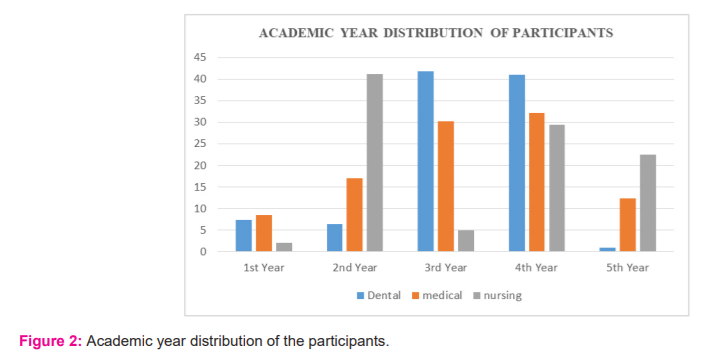


Statistically significant differences have been observed among the groups (Dental, Medical and Nursing) for the responses of the questionnaire. The correct responses have been mentioned in Table 3.
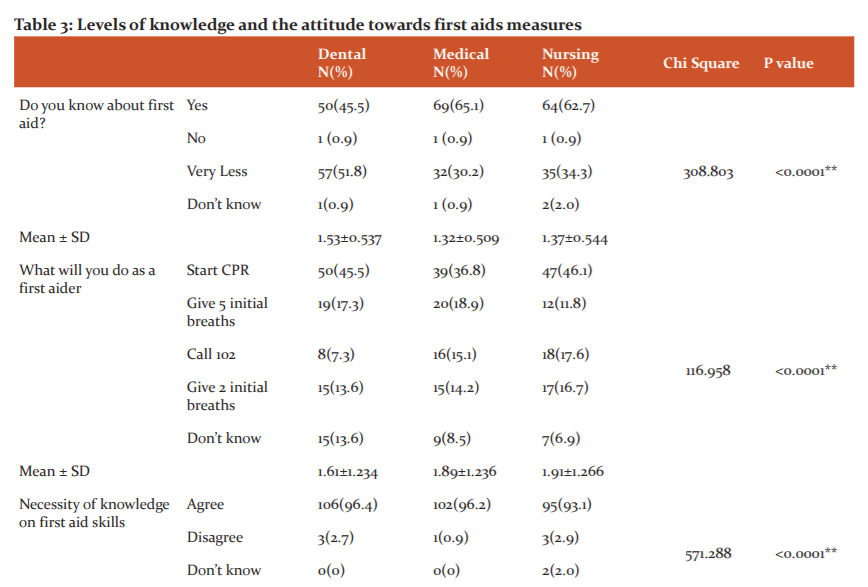
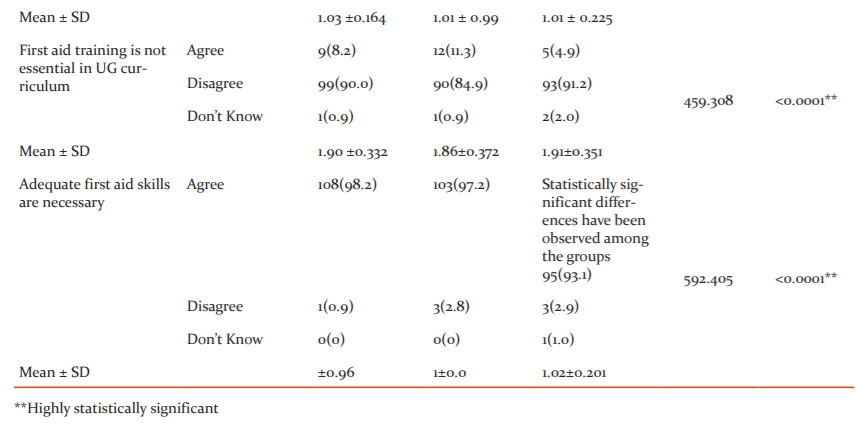
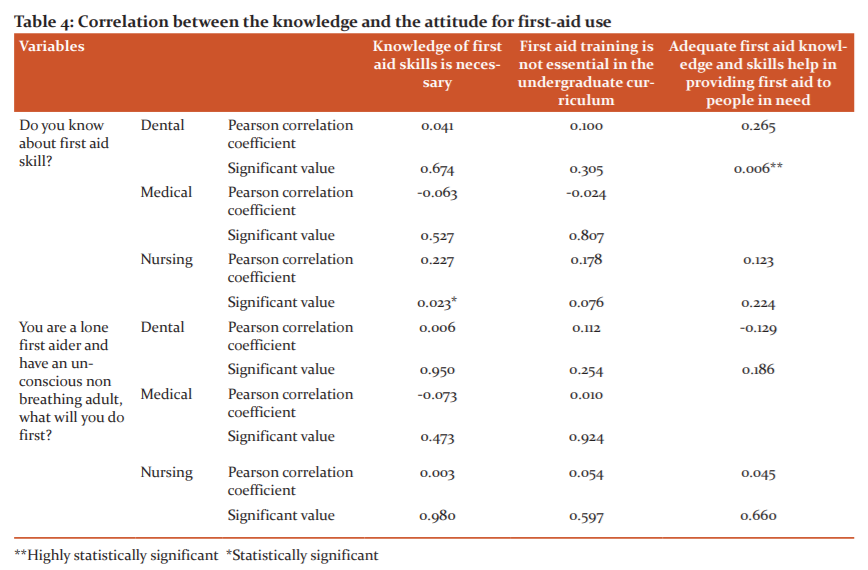
A moderate correlation was seen between the knowledge of first aid and individual knowledge levels. The findings have been mentioned in Table 4. A weak correlation was observed between the practice of an individual and the knowledge recommendation of first aid.
DISCUSSION
First aid skills play an important role among all healthcare professionals. With an increasing rate of accidents and trauma cases, the provision of first aid at the right time can result in a life-saving situation. The emergence of the COVID-19 pandemic, have put a halt to the application of these skills when managing a first aid incident. Medical, dental and nursing students can majorly contribute to improving the medical condition of a patient by acquiring adequate first aid skills and developing the right attitude towards it.
In the present study, it was found that 65.1% of the medical students were aware regarding first aid skills. Alsayali et al. in their study assessed the awareness regarding first aid among 500 participants which was found to be 56.6% good and 43.4% poor.11Medical students being more aware could be based on factors such as the acquaintance or association of them with the profession, which makes them realize the importance of first aid.11
It was observed that the majority of the participants disagreed with first aid training not being essential in the undergraduate curriculum. Similar findings were seen in a study conducted by Khan A et al. where 94.4% of medical students wanted first aid training to be part of their curriculum with 84% suggesting that it should be part of the pre-university curriculum.12 Educational institutions should make first aid and basic life support courses mandatory by incorporating them in academics through lectures coupled with hands-on practices to make it more effective.11Majority of the participants in the present study (98.2%) agreed that adequate first aid skills are necessary.
Only 45.5% of the dental undergraduate students knew about first aid skills. The findings were similar to a study conducted in Saudi Arabia where first aid courses were attended by 30.6% of the participants.11Another study done reported that 65.3% of female university students couldn’t provide first aid to the ones in need because of the lack of knowledge and other issues.13 The majority of the dental students(88%) in this study knew the management of victims with the hypoglycemic attack. In all three branches, students were not aware of the first aid skills required to arrest bleeding. Similar findings were seen in a study carried out in Mangalore where a correct response rate of 12.5% was found for both fracture and bleeding management.6
In this study, only 55.5% dental, 52.8% medical, 63.7% of nursing students knew regarding the steps of cardiopulmonary resuscitation (CPR) as a part of first aid management. In previous studies done in Salem, Tamil Nadu showed only 17.1% of medical students knowing about CPR.14 Similarly Tan EC et al. in their study observed that only 6% of the students knew and performed correct CPR.7 First aid courses and workshops should be routinely conducted and attendance should be supervised irrespective of the fields of study. This could help the students to confidently serve at the time of duty hours to serve during any life-threatening situation.
CONCLUSION
This study determined the need for introducing formal first aid training classes for medical, dental and nursing students so that students are confident enough to provide first aid in day to day situations. The study also evaluated first aid training as a felt need among the students in the academic curriculum. The study also highlighted the key areas in which first aid knowledge was lacking. More such studies should be conducted to evaluate the knowledge and attitude of first aid skills among students and healthcare workers. As healthcare professionals during the COVID-19 pandemic, we need to be aware of the risks to ourselves and others, remember our own needs and keep society informed and updated.
Financial support and sponsorship: Nil
Conflicts of interest: There are no conflicts of interest
Research quality and ethics statement: The authors of this manuscript declare that this scientific work complies with reporting quality, formatting, and reproducibility guidelines set forth by the EQUATOR Network. The authors also attest that this clinical investigation was determined to require Institutional Review Board/Ethics Committee review, and the corresponding protocol/approval number is KIDS/RES/004/2020.
References:
-
Fact sheet. Road Traffic Injuries. WHO. https://www.who.int. Accessed March 2021.
-
Elvik R. How much do road accidents cost the National Economy. Accident Analysis & Prevention December 2000;32(6): 849-51.
-
Awasthi S, Pamela G, Solanki HK, Kaur A, Bhatt M. Knowledge, attitude, and practice of first aid among the commercial drivers in the Kumaon region of India. J Foren Med Res. 2019;8(6):1994-1998.
-
Advanced Trauma Life Support. Student Course Manual. American College of Surgeons. 2018. https://viaaerearcp.files.wordpress.com/2018/02/atls-2018.pdf.
-
Raje S, Patki M, Nizami Z, Oke S. Evaluation of Knowledge and Practices about First Aid among Medical Students. Res Med J. 2017;1(2):5-8.
-
Joseph N, Kumar G, Babu Y, Nelliyanil M, Bhaskaran U. Knowledge of first aid skills among students of a medical college in Mangalore city of South India. Ann Med Health Sci Res. 2014;4(2):162-166.
-
Tan EC, Severien I, Metz JC, Berden HJ, Biert J. First aid and basic life support of junior doctors: A prospective study in Nijmegen, the Netherlands. Med Teach. 2006;28:189–92
-
Jevon P. First aid in the dental practice. BDJ Team 2016;3:16155.
-
Mathew S. Awareness of first aid among undergraduate students in Ajman, UAE. IOSR J Den Med Sci. 2016; 15(6):30-38.
-
Pei L, Liang F, Sun S, Wang H, Dou H. Nursing students' knowledge, willingness, and attitudes toward the first aid behaviour as bystanders in traffic accident trauma: A cross-sectional survey. Int J Nurs Sci. 2018;6(1):65-69.
-
Alsayali R. Awareness, knowledge, attitude and practices of first aid skills among medical and non-medical students at Taif University. WFM 2019;17(11):34-43.
-
Khan A. Knowledge, attitude and practices of undergraduate students regarding first aid measures. J Park Med Assoc. 2010;60:68-72.
-
Halawani LM, Alghamdy SD, Alwazae MM, Alkhayal WA. Knowledge and attitude of Saudi female university students about first aid skills. J Family Community Med. 2019;26(2):103–07.
-
Chandrasekaran S, Kumar S, Bhat SA, Saravanakumar, Shabbir PM, Chandrasekaran V. Awareness of basic life support among medical, dental, nursing students and doctors. Indian J Anaesth. 2010;54:121–6.
|






 This work is licensed under a Creative Commons Attribution-NonCommercial 4.0 International License
This work is licensed under a Creative Commons Attribution-NonCommercial 4.0 International License